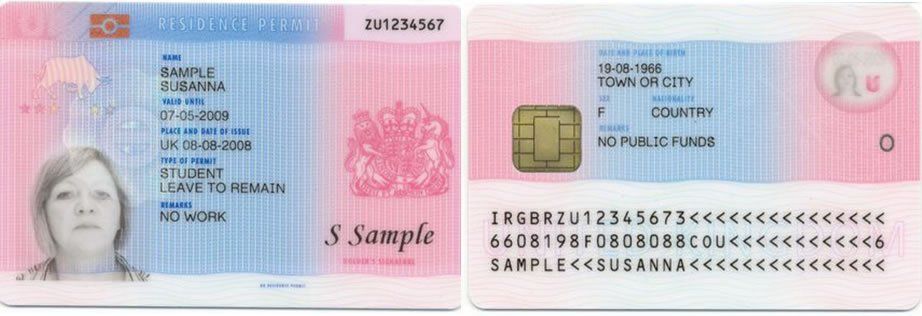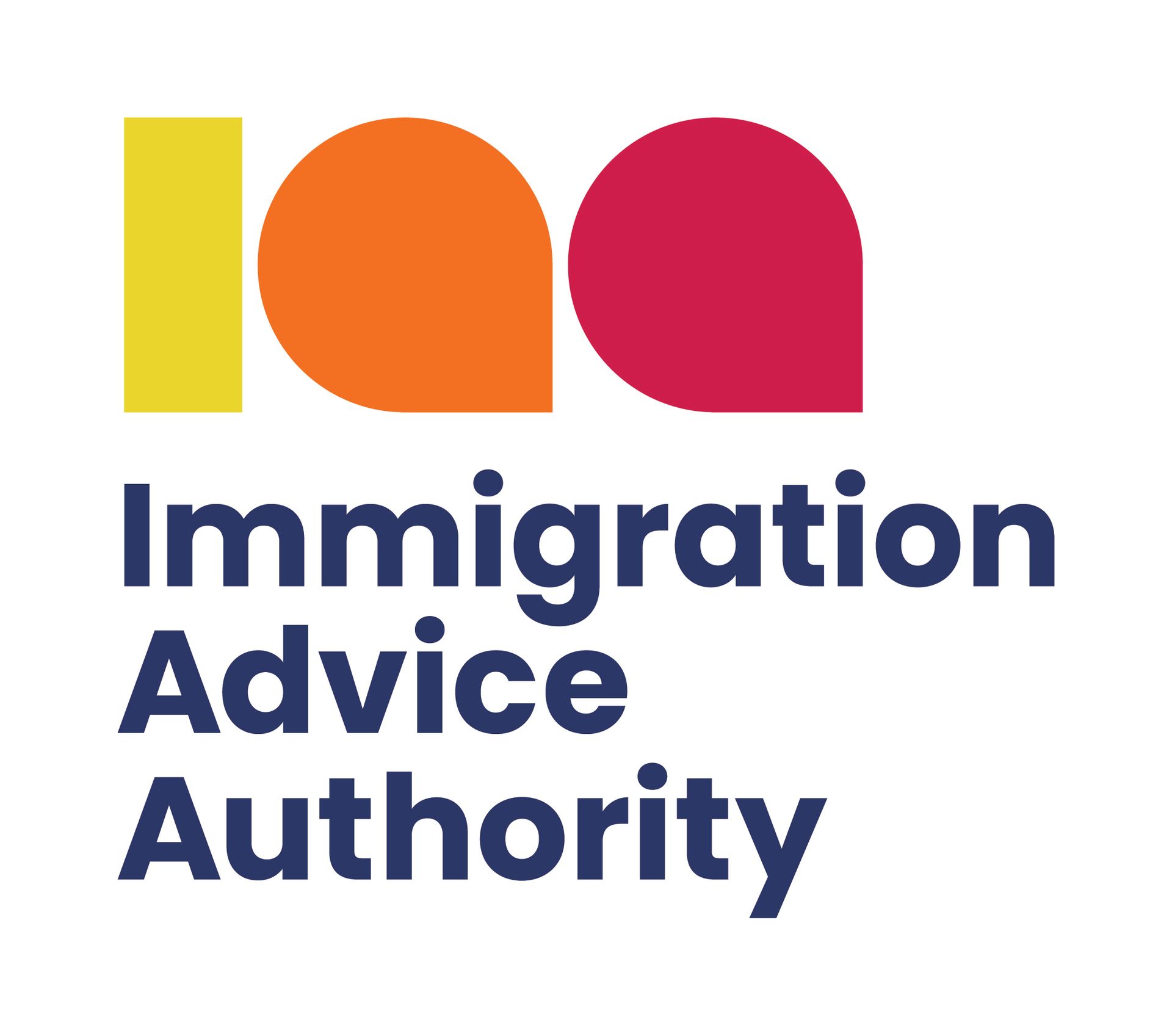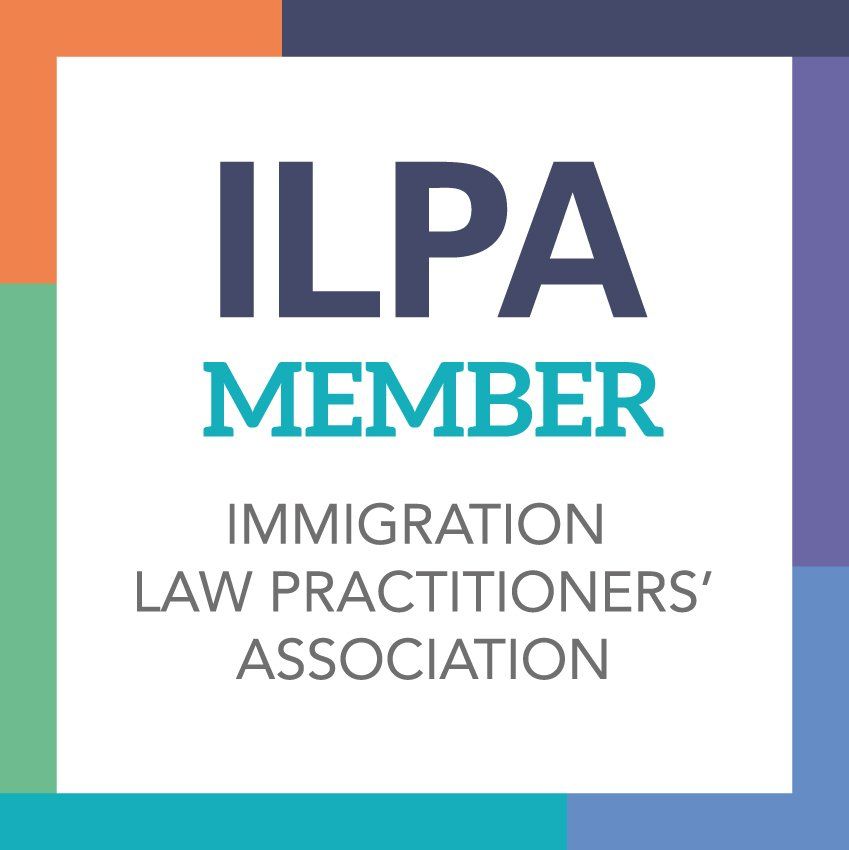Service Level Agreement (SLA)
If you been guided to this page, it means you require G4I services to support your Sponsor Licence
This page
will outline the SLA in great detail ensuring you are fully aware what you will be signing.We have provided additional information and links to help you understand your obligations when holding a Home Office sponsor licence.
We have created a link below to download a copy of Service Level Agreement
SERVICE LEVEL AGREEMENT (SLA)
If you been instructed to this page, it means you require G4I services to support your Sponsor Licence
- BRP means Biometric Residence Permit
- CoSmeans Certificate of Sponsorship (Issued to Tier 2 and Tier 5 workers)
- G4I means Global 4 Immigration
- IHSmeans Immigration Health Surcharge
- PBSmeans Points-Based System
- RLMT means Resident Labour Market Test
- RCoSmeans Restricted Certificate of Sponsorship (Issued to Tier 2 General only)
- SL means Sponsor Licence
- SLAmeans Service Level Agreement (this document)
- SMSmeans Sponsorship Management System
- SOC means Standard Occupational Classification
- UCoSmeans Unrestricted Certificate of Sponsorship (Issued to Tier 2 General only)
- UKVImeans UK Visas & Immigration (The Home Office).
- About G4I
- Client introduction
- Preventing illegal employment
- SL compliance audits
- Resident Labour Market Test (RLMT)
- SL compliance
- Compliance audit on the Client’s premises
- What do G4I or the UKVI look for when a SL audit is carried out?
- The 5 key areas that the Client must be compliant with
- Keeping the right staff records
- What documents must the Client keep
- Types of data the Client should keep
- SL training
- HR & SL compliance
- HR & SL setup
- Head office & branches
- Clients that own multiple entities that are trading under different HMRC unique payrolls
- Having the right people assigned to the Client SL
- Role of the Authorising Officer
- Role of the Key Contact
- Role of the Level 1 Users
- Role of the Level 2 Users
- Role of a representative
- Who cannot be assigned a CoS?
- SL Clarification
- CoS clarification
- CoS introduction
- What are UCoSs
- What are RCoSs
- What are standard CoSs
- What are priority CoSs
- Certifying Maintenance
- Right to work evidence for overseas nationals
- BRP clarification
- What does UKVI look for when they carry out a SL audit?
- Tier 2 & 5 workers
- Contracting Out Tier 2 & 5 Workers
- Sponsor Duties
- Outsourcing
- Responsibilities
- Visa process guide
- SL support services
- Support clarification
- What support will the Client receive under their package?
- Non-SMS support services
- Changes made in SMS
- Additional support services
- Visa services
- Chargeable immigration support services
- Visa & purchase order process
- Summary of contractual terms
- Rate card
- SLA Authorisation
List of Services
- Resident Labour Market Test
Learn more >> List Item 1
If the Client organisation intends to employ non-EU nationals requiring sponsorship, they are required to carry out a Resident Labour Market Test unless a particular job role is deemed to be on the exempt list.
- Sponsor Licence Training
Learn more >> List Item 2
If staff employed by the Client that are involved in the hiring and firing process are not 100% in the know when dealing with non-EU nationals, our training could prevent non-compliance.
- Sponsor Licence Auditing
Learn more >> List Item 3
If the Client was visited by the UKVI compliance officers, would their organisation pass or fail the audit? The organisation must comply to the 5 key areas of holding a sponsor licence to retain A-Rated status.
- Preventing Illegal Employment
Learn more >> List Item 4
Did the Client know if the UKVI found a person working illegally in their organisation, they can be issued a £20,000 civil penalty per illegal worker and in more serious cases issued a custodial sentence.
- Recruitment Cycle
Learn more >>
Every organisation should have a recruitment process that they follow and it is fully compliant. Can the Client afford HMRC, Home Office and other regulating bodies finding their organisation being non-compliant?
- Workforce Compliance
Learn more >>
It is a legal requirement to have a workforce that is fully compliant (employed and contracted) and the system(s) in place are ‘fit for purpose’ which can be paper-based, electronic or a combination of both
- UK settled workers (this includes people holding Indefinite & Permanent Residency status)
- EU national’s clarification wanting to work in the UK can include:
- Direct EU, EU or Swiss citizen.
- Direct family member of an EU, EEA or Swiss citizen holding a passport from outside the EU*.
- Extended family member of an EU, EEA or Swiss citizen**.
- Family member of a British citizen who also has EU, EEA or Swiss citizenship and who lived in the UK as an EU, EEA or Swiss citizen before getting British citizenship.
- Non-EU nationals with permission to live and work in the UK who fall outside of the immigration rules.
- Non-EU nationals with permission to live and work in the UK and within the immigration rules with permission to switch visa routes into Tier 2 or Tier 5 without having to leave the UK.
- Non-EU nationals with permission to live and work in the UK and within the immigration rules with no permission to switch visa routes into Tier 2 or Tier 5 but can leave the UK and apply to enter the UK under a new entry visa category such as Tier 2 or Tier 5.
- Non-EU nationals not in the UK wanting permission to enter the UK to work under Tier 2 or Tier 5.
- Downgrade SL to a B-rating
- Suspending SL
- Does the Client meet all of the criteria or are fully compliant?
- Does the Client only meet some of the criteria or are partially compliant?
- Does the Client meet any of the criteria or are non-compliant?
- The worker's contact details (address, mobile telephone number and if applicable telephone number), must be kept up to date; and
- A photocopy or electronic copy of the worker's passport or UK immigration status right to work document (usually a BRP card), see clause 13 for further details that shows their entitlement to work and the length of their permission to remain in the UK.
- The Client should keep records and copies of contract of employment, employment condition changes, all pay slips, pay rises and pay decreases, employment hours, contact details and job descriptions and job promotions. Certain information must be reported in the SMS to the Tier worker CoS. If the Client carried out a RLMT to employ a worker then keep a copy of the job advertisements, the URL link and the links to the jobs-boards that they used plus, records of who applied to the job, reasons for rejections, interview notes and who as shortlisted.
- If the Client placed a Tier worker to a third-party site, they would need to ensure the work being carried falls under the SOC code that was assigned to that worker and employment conditions followed. The Tier worker must be under the Client control at all times and any third-party involvement is not permitted to subcontract the Client Tier worker out to another third party or, take control of that Tier worker or dictate the work agreed upon. If the Tier worker is required to live at a different location because of the work transfer; the worker must complete and send to the UKVI a change of circumstances form to inform of their change in circumstances. Note: If the third-party requires their Tier workers to work in a different location to the contract agreement then this is likely to be a breach. Contact G4I for guidance prior to any assignment. The Client must also record a change of circumstances if the Tier worker role or details changes within their SMS.
- Online either one-to-one or in a group.
- Face-to-face either one-to-one or in a group.
- Single property
- Head office and branches
- Authorising Officer
- Key Contact*
- Level 1 Users*
- Level 2 Users**
- add Level 1 and 2 Users and remove them;
- assign CoSs to workers;
- ask for the Client CoS annual allocation to be increased;
- update the UKVI via the Client SMS of their workers work changes;
- use the 'change of circumstances' section to ask the UKVI to record SL compliance changes in their or worker’s circumstances;
- report worker activity to the UKVI (such as telling the UKVI if a worker goes missing, does not attend their job or employment ends early);
- withdraw the workers CoS;
- manage the Client work addresses; and
- amend User details.
- assign CoSs to workers; and
- report worker activity (for example, if they leave their job or do not arrive for work).
- A Level 2 User can only search for CoSs that they have entered.
- A Level 2 User can be a temporary member of staff supplied by an agency.
- Spouse or civil partner
- Unmarried or same-sex partner
- Parent or step-parent
- Son or step-son
- Daughter or step-daughter
- Brother, step-brother or half-brother
- Sister, step-sister or half-sister
- Nephew, niece, cousin
- Father-in-law, mother-in-law, brother-in-law, sister-in-law, son-in-law or daughter-in-law.
- The Client needs to login to their SMS and request the number required on or before the 5th of the month. UKVI will expect the Client to provide key information in the RCoS such as SOC code, salary, employment hours, job description and where job advertised.
- Between the 6th to the 10th UKVI are likely to request an array of documents and data regarding the RCoS request. Failure to supply this data the RCoS will be refused or if the Client provides the wrong data, the RCoS will be refused and could trigger a site audit.
- 3. By the 12th of that month the UKVI panel will either approve or reject the request(s) as long as process 2 is completed in time. If the UKVI approves the RCoS then the Client can assign the worker details to it. If the RCoS is rejected, the Client can request the RCoS to be considered the following month.
- Entry visa sticker issued to non-EU nationals entering the UK (30 days temporary visa)
- BRP card collected once in the UK (replaces entry visa sticker)
- BRP cards issued when renewing UK visas in the UK
- EU nationals holding a Registration Certificate or Document Certifying Permanent Residence issued by the Home Office to a national of a European Economic Area country or Switzerland*.
- Non-EU national family members entering the UK (temporary 6 months visa sticker)
- A current Immigration Status Document issued by the Home Office to the holder with an endorsement indicating that the named person is allowed to stay indefinitely in the UK or has no time limit on their stay in the UK, together with an official document giving the person’s permanent National Insurance number and their name issued by a Government agency or a previous employer.
- A certificate of registration or naturalisation as a British citizen, together with an official document giving the person’s permanent National Insurance number and their name issued by a Government agency or a previous employer.
- How the Client recruited the worker that falls under their SL. This is likely to include how the RLMT was carried out, applications shortlisted process, interview notes and verified each applicant skill sets.
- Did the Client exclude a UK settled worker application when hiring a Tier worker?
- Is the job position genuine or manufactured?
- Assigned the CoS in accordance to the RQF level required?
- Assign the right SOC code to the relevant job description?
- Does the salary, commissions, bonuses reflect what is stated on the CoS and RLMT and employment contract?
- Are the Clients Tier workers doing the job as specified in their CoS/Job description and if applicable what the job was advertised at?
- Tier workers working at the location as stipulated in the Tier worker CoS?
- Tier worker pay greatly increased after employment commenced?
- Did the job start as per the start date on the CoS, if not what is the reason?
- Did the Client track expiry dates when a CoS and BRP expires?
- Does the Client keep a daily record of the worker attendance?
- If the worker works off-site, can the Client demonstrate the work was carried out?
- The Client log paid and unpaid leave?
- Did the Client record and comply with the paid and unpaid holiday/leave employment guidelines?
- If the Tier worker job changed, does the work changes fall within the same SOC code?
- Any Tier 2 workers engaged under entrant salary, are the salaries amended too 'experienced' after 3 years when the Client assigns a new CoS?
- Does the Client know when any non-EU national visa and other right to work data will expire?
- If a worker failed to turn up to work, does the Client know what to do and when to update their SMS.
- Does the Client know how to update UKVI on their business and Tier workers?
- If the Client transferred a worker to another site or job type, does the Client know the process?
- Does the Client know the difference between an Unrestricted and Restricted CoS?
- Does the Client know what visa workers can be engaged without SL permission?
- Can the Client employ a worker from another sponsor?
- Can the Client engage volunteers that need permission to be in the UK and do the Client know the hours they can volunteer?
- Did the Client get a B2B contract signed with this third-party business?
- Did the contract cover the following
- Confirm the worker is under tier sponsorship?
- Tier worker is under your control and supervision?
- Tier worker cannot be disciplined by the third-party business?
- Tier worker cannot be contracted out to another third-party business?
- Tier worker must be paid directly by your organisation and not the third-party?
- Work carried out falls in line with the SC code and job description stated in the assigned CoS?
- Pay offered to do the third-party work complies to the salary in the assigned CoS?
- Employment hours complies to the salary in the assigned CoS?
- If the tier worker is moved to site to site, did you add a worker note to inform UKVI of address the tier worker is based at?
- Did you confirm in the RLMT that the job was off-site under a B2B contract?
- Did you confirm on the CoS the work is off-site?
- Did the Client keep a daily record of worker working activities on the third-party premises?
- Did the Client have evidence of work carried out on Client’s premises?
- Did the Client enter in the assigned CoS work dates greater than the B2B contract?
- Is the Client Authorising Officer, Key Contact, Level 1 and Level 2 Users details correct in their SMS?
- Has the Client applied for their annual CoS allocation by the agreed time?
- Are the Client and any branch details up to date within their SMS and this includes changes to properties opening, closing, change of ownership etc.?
- The SMS is updated when changes are made to workers conditions?
- If the Client has multiple properties assigned to their SL, are these properties workers up to date?
- Has the Client filed all RLMT carried out where they engaged any Tier workers, this should include CVs applied, cover letters, qualifications, references, licences if applicable, who was rejected, shortlisted, interviewed, DBS checks if applicable and right to work screening when pre-engaging the non-EU national?
- Did the Client update their SMS within 10 working days if any Tier worker circumstance changes?
- If any employment changes after the CoS was assigned, has it been updated in the Client SMS?
- Where Tier workers receive a considerable pay increases, has this been added to the workers CoS as a worker note within the Client SMS?
- If the Client cancelled any CoS or worker does not turn up to do the job, are these CoSs updated/cancelled in the Client SMS?
- Visa checking service pre-engagement.
- Training program for the Client staff responsible for managing non-EU national workers.
- Annual audit to help keep the Client HR and compliance in order.
- G4I can introduce to the Client a legal law firm that provides an array of employment documents and employment legal advice.
- Change to trading premises, ownership (UK or overseas parent company) includes shareholders and trading name etc.
- Adding new business entities to their SL if they Client plans to move tier 2 staff to these premises.
- Changes to Authorising Officer, Key Contact, and Level 1 and 2 Users
- Annual allocation of CoSs, processing CoSs, cancelling CoSs etc.
- Adding a worker note when changes happen to tier workers.
- Client confirms to G4I they like to sponsor a non-EU national
- G4I confirms with the Client if a RLMT is required
- RLMT is carried out if applicable
- Client provides G4I draft of employment letter and job description
- Client completes G4I CoS form and emails to G4I
- G4I agrees job advert, CoS, employment letter and job description are correct
- Client confirms with G4I who will pay UKVI and G4I fees
- G4I requests that the Client introduces the applicant to G4I
- G4I contacts the applicant and verifies their details and explains the visa process
- Applicant confirms by email they wish to proceed with G4I services
- G4I prepares care letter and emails the applicant to register on G4I website
- Applicant registers on G4I website and signs business T&Cs and care letter
- G4I invoices approved party
- G4I confirms by email when payment is received into the client account
- Applicant and employer provide G4I with documents required
- G4I prepares registers UKVI visa account
- G4I completes visa application form and requests applicant to verify the data
- Approved person pays UKVI visa fees as Standard, Priority or Super Priority
- G4I creates UKVI commercial partner account
- G4I books in commercial partner the applicant biometrics appointment
- G4I uploads applicant documents to commercial partner portal
- G4I consults the applicant on how to attend their biometrics appointment
- UKVI will email G4I an array of emails which G4I emails to the applicant and employer
- UKVI should update G4I when a visa decision is made.
- Leave to Enter – if visa is approved, applicant receives 30 day visa sticker to enter the UK with visa approval letter and once in the UK collects their biometric card,
- Leave to Remain – if visa is approved, applicant receives new BRP card and visa approval letter.
- If visa refused, G4I will update the relevant parties on their options.
- Consider all payroll per business entities under their group.
- If the Client has several entities under one SL, it is possible each entity has its own payroll set up with HMRC. The Client is required to count all employees on their payroll and volunteers and tick the appropriate box below.
- If the Client engages charity workers, this must be added to the total.
- Level 1 User
- Key Contact (optional)
- Draft and Assign CoSs to approved Tier workers
- Cancel any assigned CoSs
- Add Tier worker notes to assigned CoSs
- Update the Clients SMS when changes are required
- Prior to engagement of Tier worker, check their right to work status
- Request annual CoS new allocation
- Request ad-hoc CoS allocation
- Request priority CoS
- RCoS is part of the Tier 2 General application fee
- Update UKVI on Level 1 Users, Level 2 Users, Key Contact, Authorising Officer, Business change of address, new branches acquired or needs adding to their SMS, Client change of business ownership etc.
- Provide template maintenance support letter
- Provide template sponsorship letters
- Verify if employment contracts comply to Tier workers
- Verify if job descriptions comply to Tier SOC code
- Verify if Mission statements complies (Tier Religious workers only)
- Verify job posting adverts are compliant
- Request further clarification on changes requested or
- Proceed and update the Client SMS.
- Points-based System training
- SL training specific training
- Client site visit auditing
- How to process a compliant recruitment cycle
- How to assign a new entity to the Client existing SL. A new entity is governed by payroll and if additional staff takes the Client into a new package, the Client will be invoiced the variance.
- Single application
- Single application and family members joining the non-EU national later on.
- Family group applications – applying at the same time.
- Tier priority or super priority applications for non-EU nationals.
- standard online application (allow 3 weeks* processing time) or
- priority application (allow 5 working days processing time) or
- super priority application (allow 1 working day processing time).
- standard online application (allow 8 weeks* processing time) or
- priority application (allow 5 working days processing time) or
- super priority application (allow 1 working day processing time).
- standard online application (allow 6 months* processing time) or
- priority** application (allow 5 working days processing time) or
- super priority application (allow 1 working day processing time).
- Client contacts G4I and agrees to sponsor Worker X and confirms who pays the following fees:
- Visa fee
- IHS fee
- Priority or Super Priority fee if applicable
- G4I costs
- Costs associated to A) to C), the relevant party who pays these costs must have a payment card with funds available.
- Costs associated to D), the relevant party who pays this cost will be invoiced by G4I.
- The Client fully understands that G4I cannot be accountable or responsible for being the Authorising Officer.
- the Client fully understands that G4I cannot be accountable or responsible for actions taken by the Client or any of their staff.
- The Client fully understands their rights and takes full responsibility to inform G4I of any changes to their Client business or workers details if G4I is required to update their SMS.
- The Client is responsible for hiring and firing of their staff and at no time can G4I influence or get involved with employment contracts or disputes.
- The Client is contracting G4I to provide support services for their SMS and helping to prevent illegal employment and when required process visa applications.
- The Client will at all times comply to UKVI guidelines on the 5 key areas of good HR practices and discourages any type of illegal activities.
- G4I will not discriminate against any person and endeavours at all times to provide impartial advice in accordance to the OISC, UKVI, Employment Law and Equality Act 2010 guidelines.
- This SLA is valid on date it is signed and when the current SL expires unless G4I states otherwise.
- 9. If the Client agrees to extend their SL, the SLA will need renewing which will be for 4 years and G4I will invoice the Client based on their staff and charity workers/volunteers engaged.
- If the Clients’ SL is ‘revoked’ by UKVI, this SLA will be terminated on the date the SL is revoked. The Client will not be entitled to any refund. If the Client can get their SL reinstated, then this SLA agreement will be activated again only if they win their challenge or appeal. If UKVI insists the Client to apply for a new SL, a new SLA and fee will need to be paid. In most cases a Client cannot reapply for a SL until 12 months has elapsed from the date the previous SL was revoked.
- If the Clients’ decides to withdraw their SL, this SLA will be terminated. The Client will not be entitled to any refund. If the Client decides to apply for another SL, the Client must sign a new SLA and pay the G4I fee again base on payroll staff and charity workers.
- If the Client adds additional entities to their SL and the staff count falls within the SLA level, the Client does not have to pay G4I additional SLA fee. If the staff count goes over the SLA level, G4I will invoice the Client the variance and update this SLA.
- If the Client downsizes their business and their staff count falls to a lower level SLA fee, no refund will be permitted. When the Client renews their SLA with G4I, the new SLA fee will comply then.
- The Client accepts that no refund is possible once the agreement has been signed regardless if they paid the invoice or not.
| Payroll and Charity workers/volunteers engaged totals | G4I Set SLA Fee |
|---|---|
| 1-50 | £750.00 |
| 51-100 | £1000.00 |
| 101-250 | £1250.00 |
| 251-500 | £1500.00 |
| 501-1000 | £2500.00 |
| 1001-2000 | £3000.00 |
| 2001+ | £TBC |
Contact Us
We will get back to you as soon as possible.
Please try again later.
-
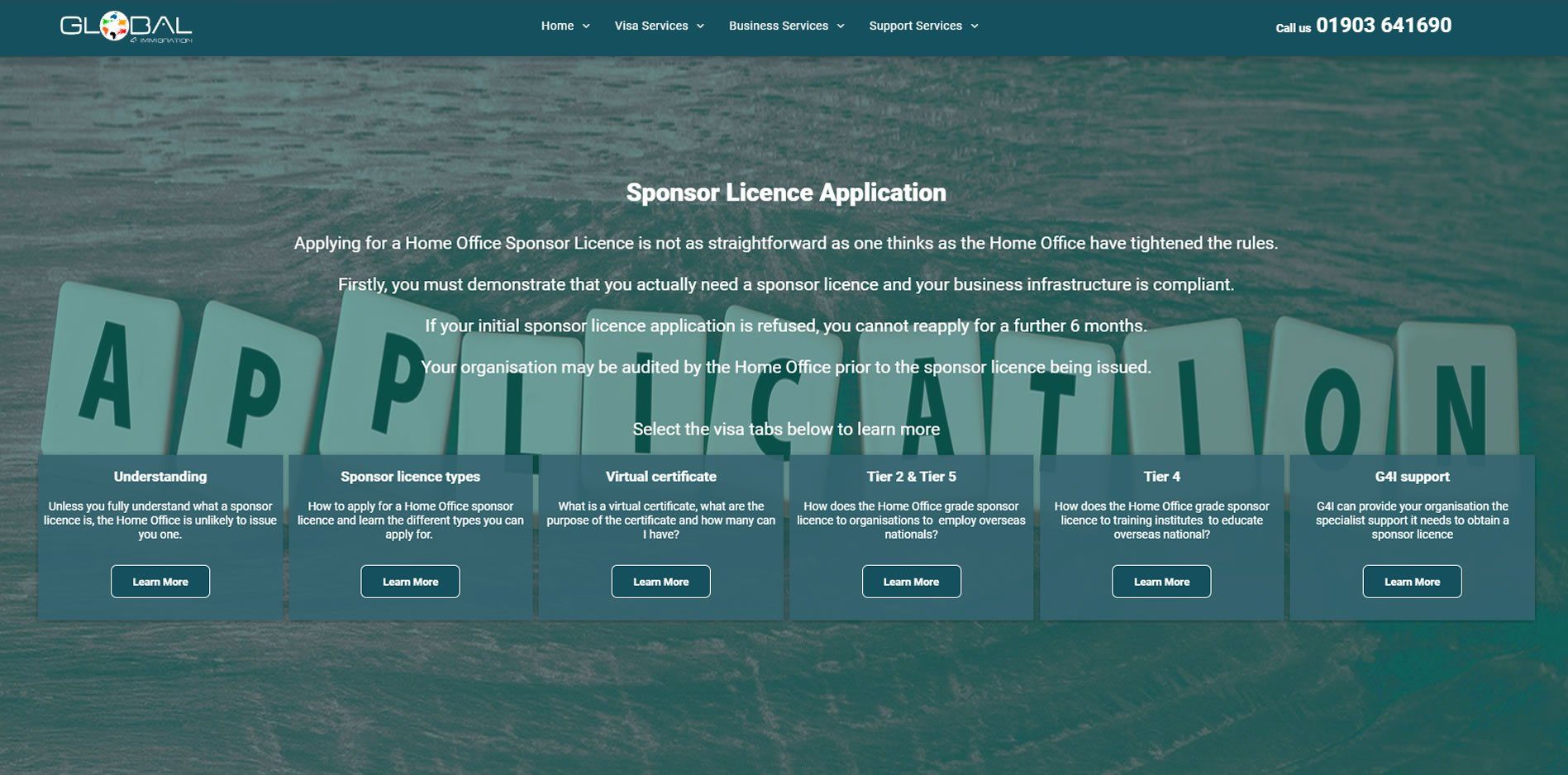
Sponsor Licence Application
Learn here how you can sponsor licence overseas nationals under Tiers 2 and 5. Learn More >>
Learn More>> -
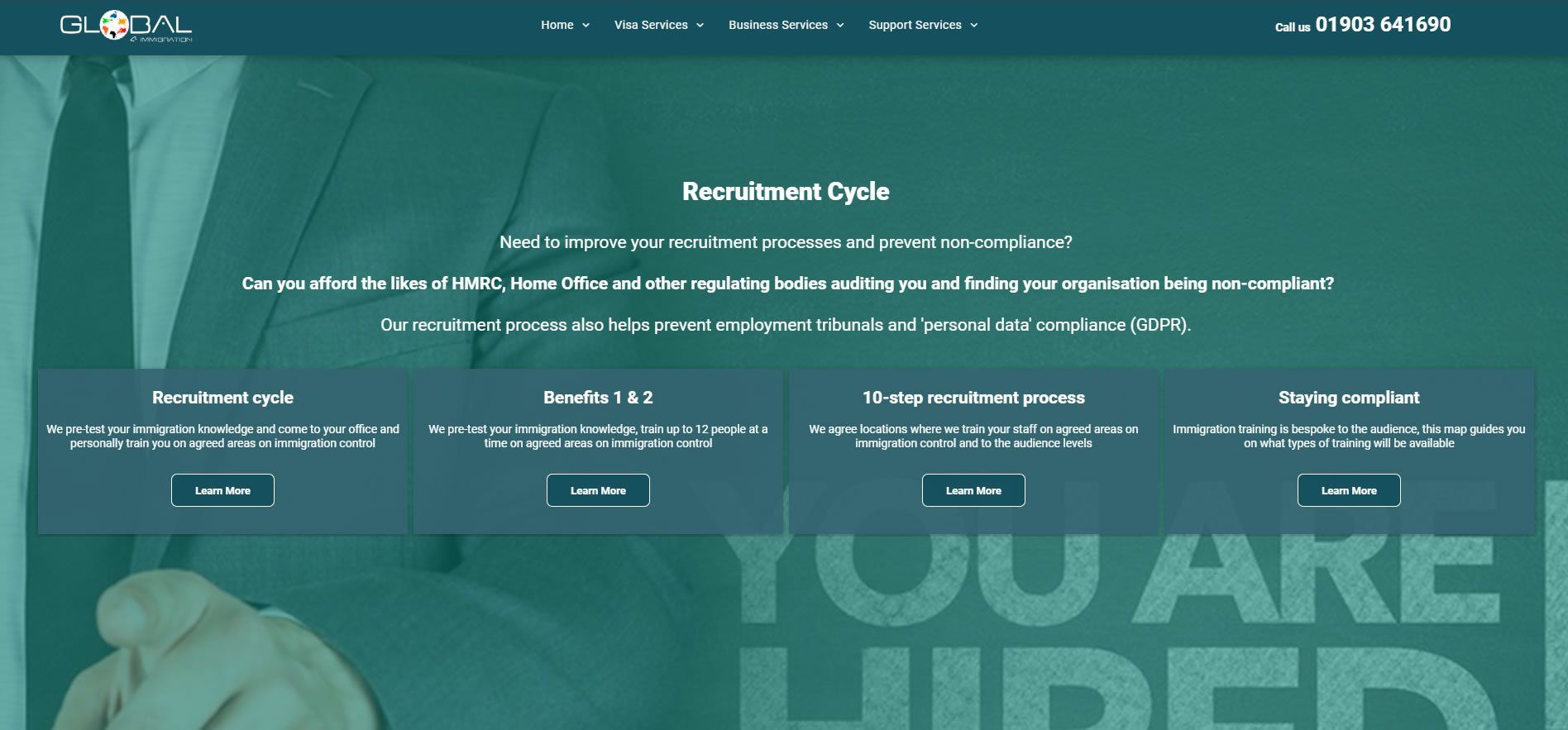
Recruitment Cycle
If your business needs to know how to form a robust recruitment process. Learn More >>
Learn More>> 
Sponsor Licence Maintenance
Need to ensure your sponsor licence is not revoked by the Home Office, learn here how we can help you. Learn More >>
Button-
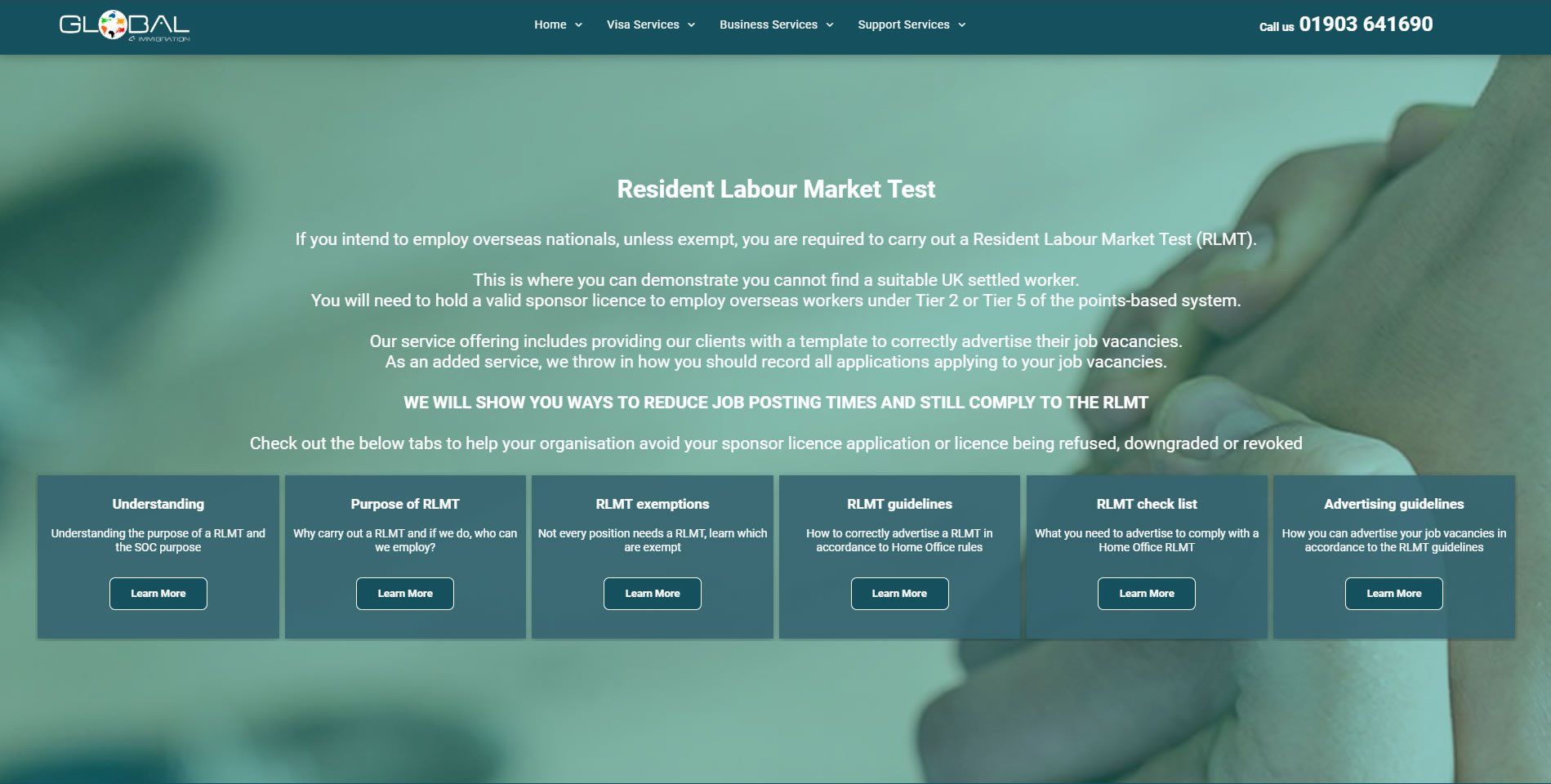
Resident Labour Market Test
Learn how best to advertise job vacancies when hiring sponsored workers needing a visa. Learn More >>
Learn More>> -
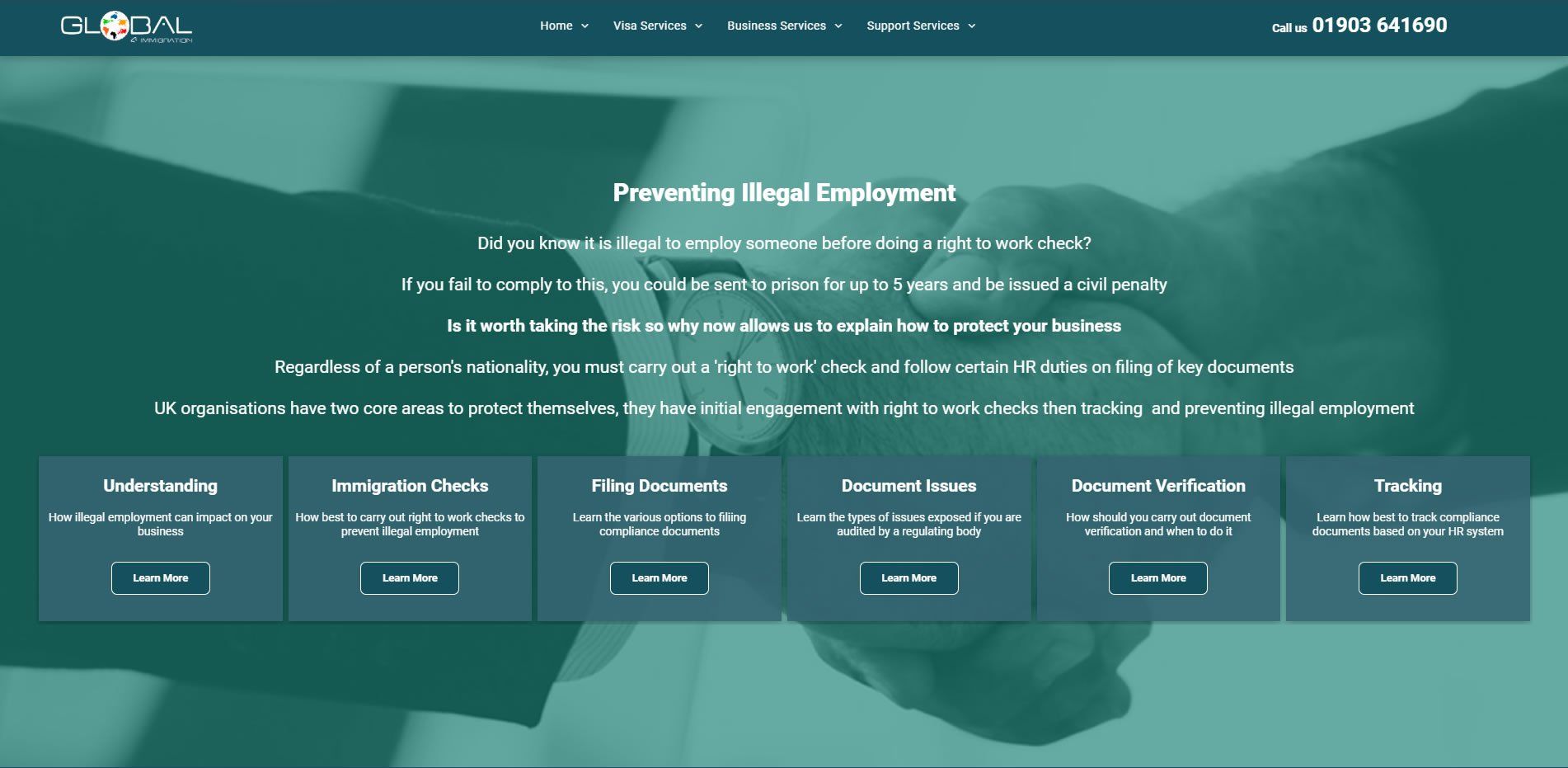
Preventing Illegal Employment
Want to prevent receiving a civil penalty of £20,000 per ilegal worker. Learn More >>
Learn More>> -
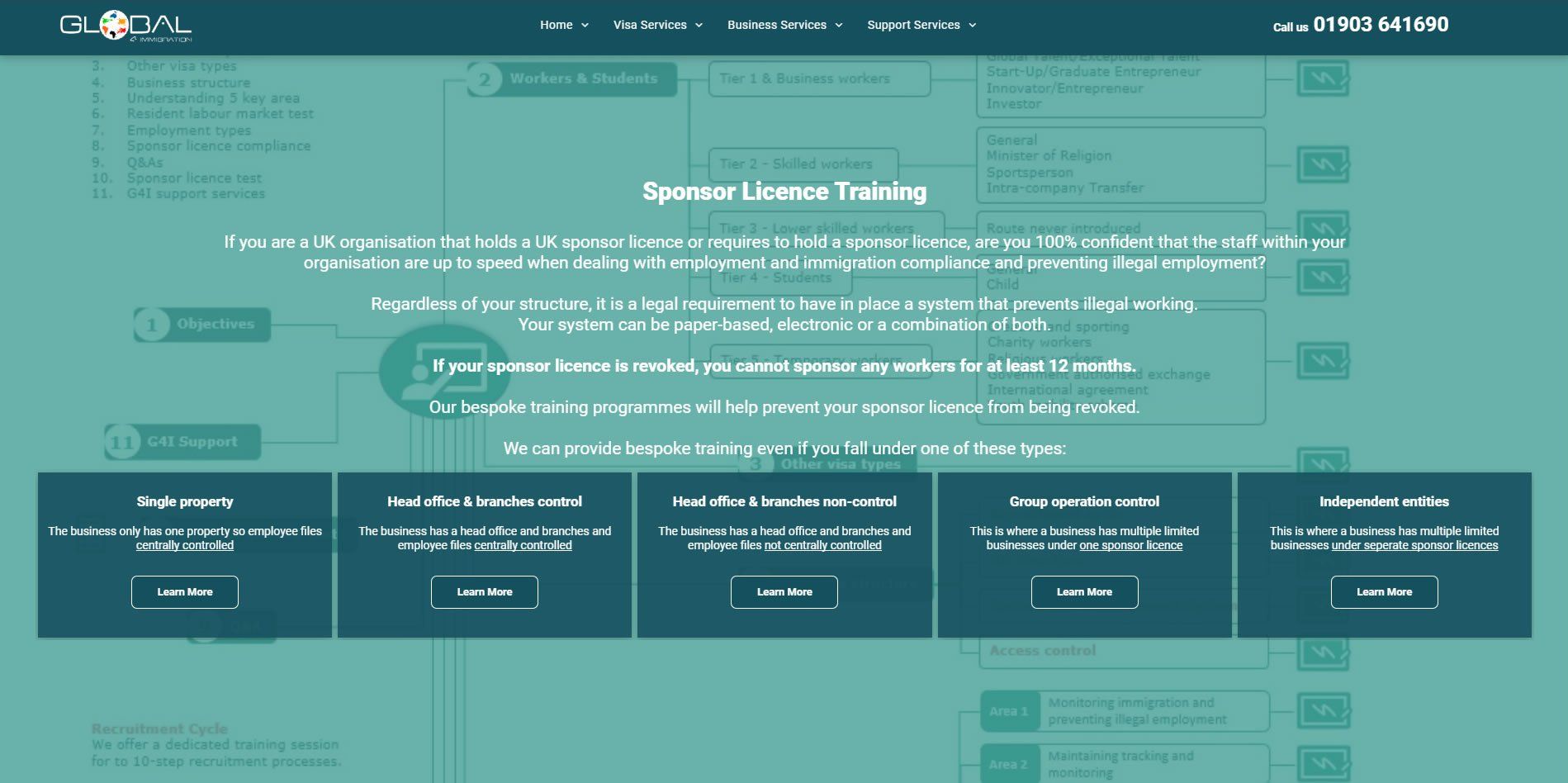
Sponsor Licence Training
Learn how to correctly to manage your sponsorl icence duties in line with the Home Office guidance. Learn More >>
Learn More>> -
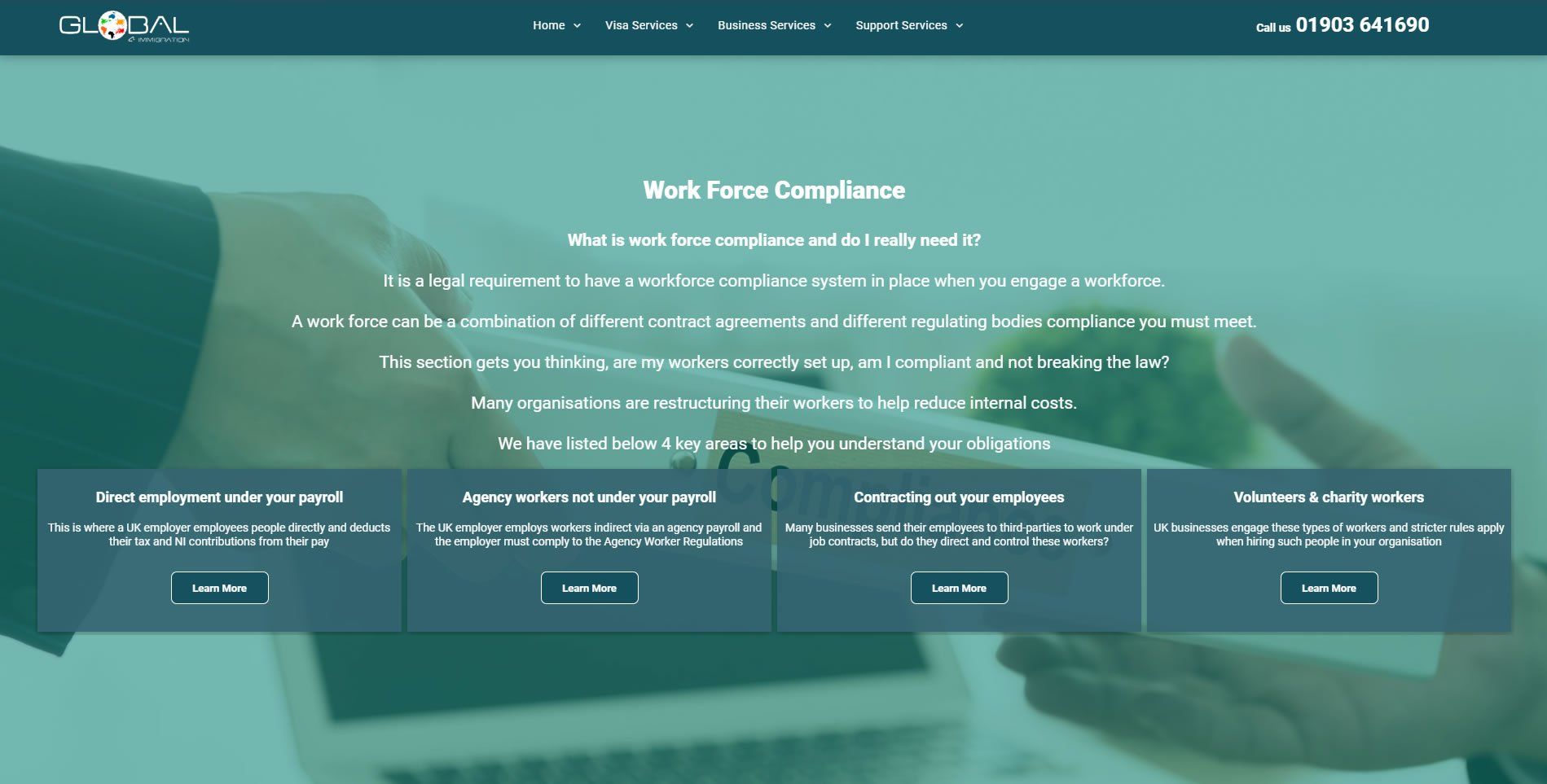
Work Force Compliance
Learn how to ensure all workers are legally compliant to work for your organisation. Learn More >>
Button -
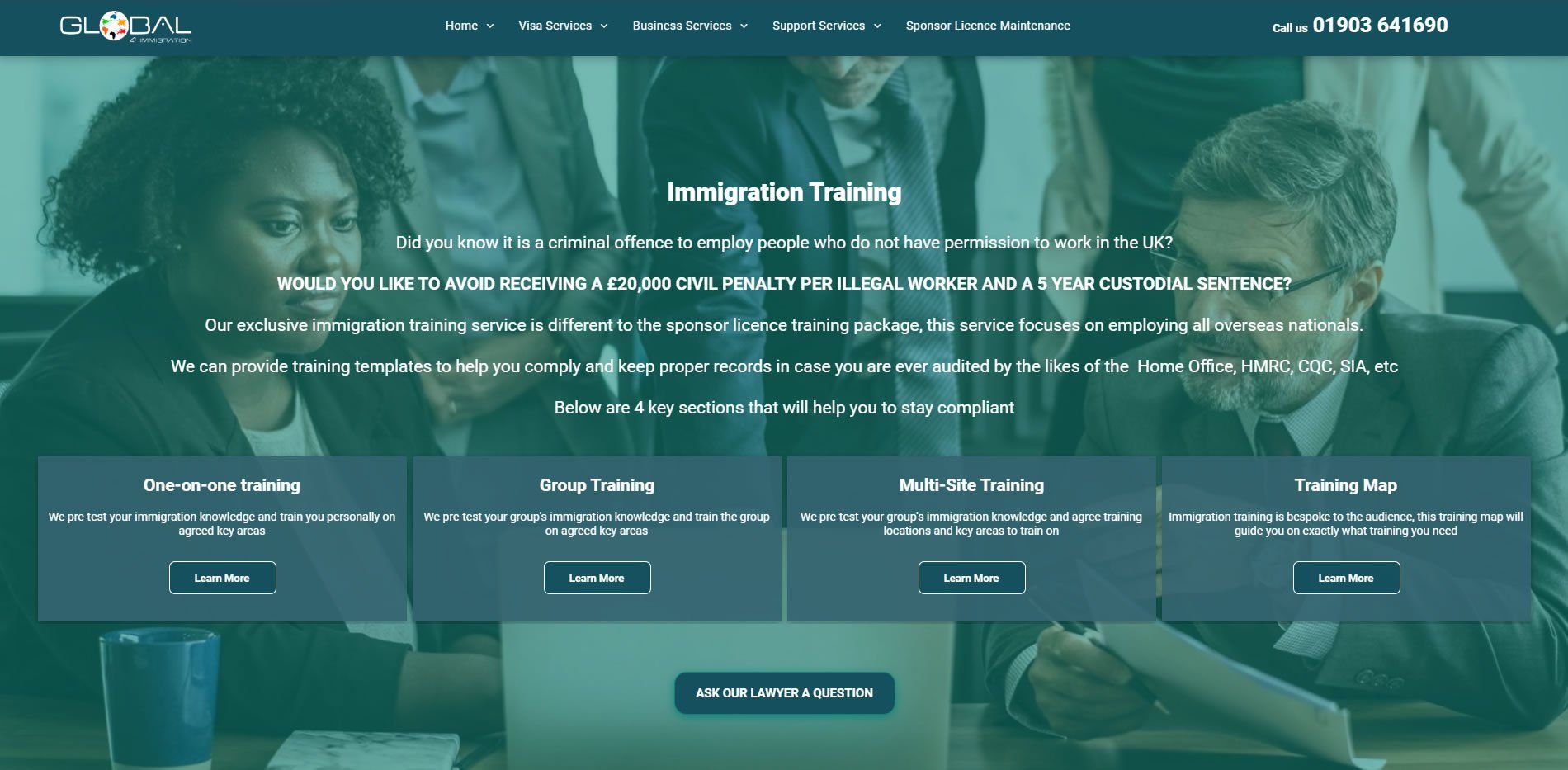
Immigration Training
Learn how to ensure all migrants workers are legally compliant to work for your organisation. Learn More >>
Button -
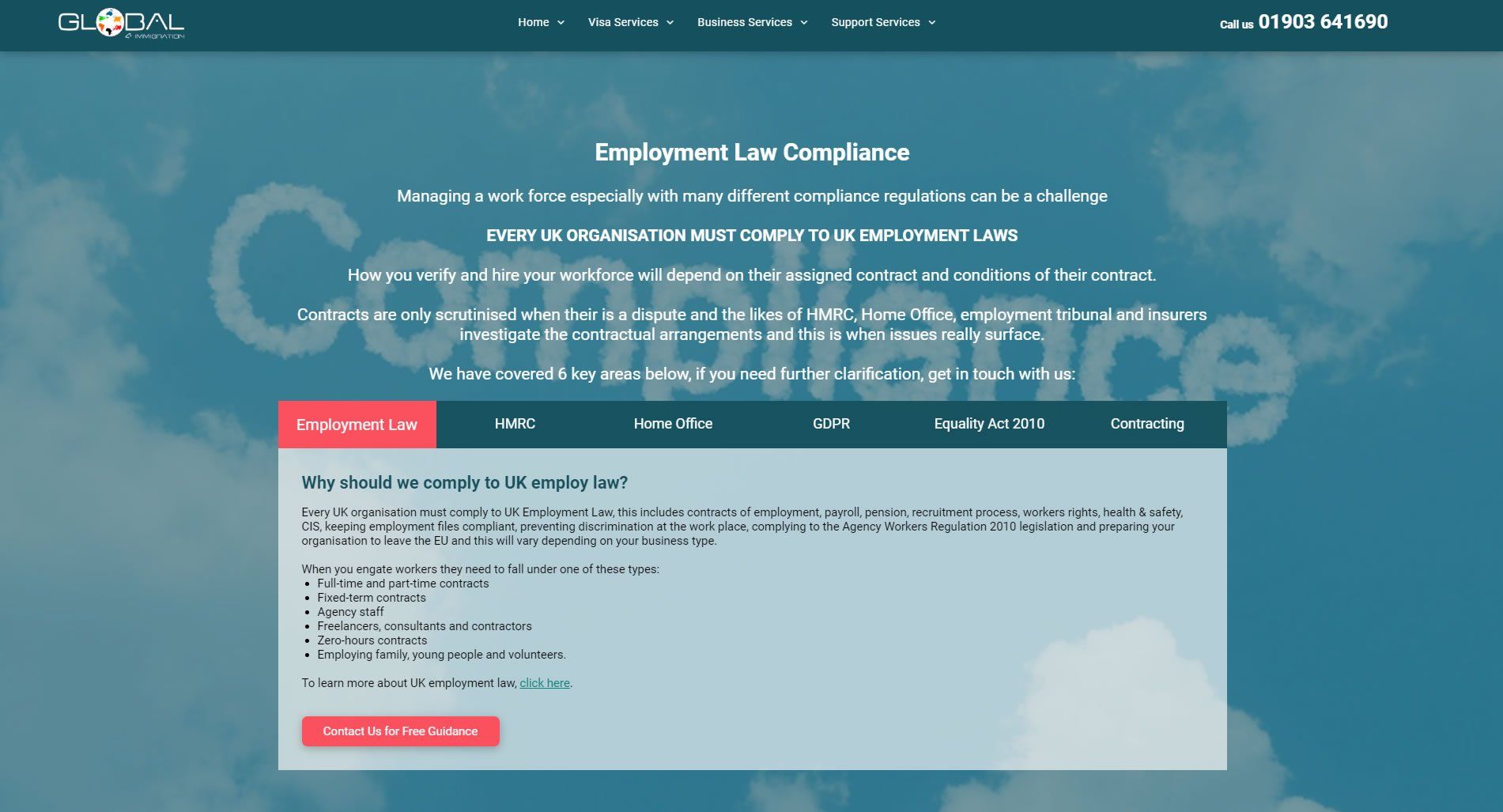
Employment Law
Every organisation mut comply to empoyment law, learn more how our firm can support you. Learn More >>
Button -

Contracting Compliance
Contracting workers is becoming the norm to reduce costs, learn how G4I can support your organisation. Learn More >>
Button -
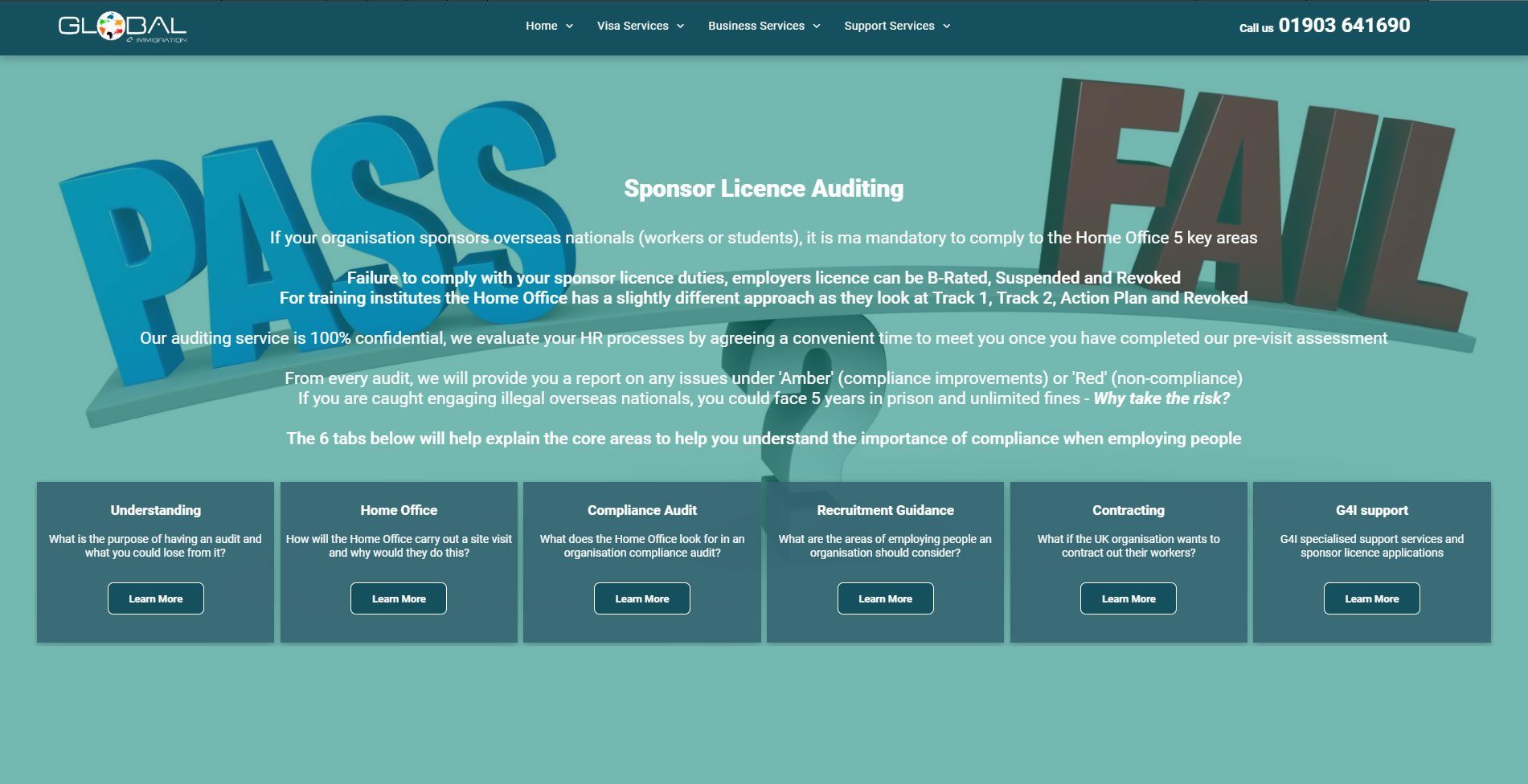
Sponsor Licence Auditing
Want to prevent your sponsor licence being revoked and losing your staff? Learn More >>
Button
-

ENTRY VISA BASED ON PARTNER ROUTE
I was given wrong advice by UK Border Control until I spoke to G4I
Learn More -

TIER 2 GENERAL TO UK SETTLEMENT STATUS
The immigration rules were changing meaning I would not qualify for settlement until G4I showed me how
Read More -

ADULT & CHILD SETTLEMENT/NATURALISATION
Our children had dual nationality, we were concerned if they could settle and become British, G4I resolved all of our concerns
Read More
NEED A QUESTION ANSWERED?
Thank you for contacting us.
We will get back to you as soon as possible
Please try again later
- BRP means Biometric Residence Permit
- CoSmeans Certificate of Sponsorship (Issued to Tier 2 and Tier 5 workers)
- G4I means Global 4 Immigration
- IHSmeans Immigration Health Surcharge
- PBSmeans Points-Based System
- RLMT means Resident Labour Market Test
- RCoSmeans Restricted Certificate of Sponsorship (Issued to Tier 2 General only)
- SL means Sponsor Licence
- SLAmeans Service Level Agreement (this document)
- SMSmeans Sponsorship Management System
- SOC means Standard Occupational Classification
- UCoSmeans Unrestricted Certificate of Sponsorship (Issued to Tier 2 General only)
- UKVImeans UK Visas & Immigration (The Home Office).
- About G4I
- Client introduction
- Preventing illegal employment
- SL compliance audits
- Resident Labour Market Test (RLMT)
- SL compliance
- Compliance audit on the Client’s premises
- What do G4I or the UKVI look for when a SL audit is carried out?
- The 5 key areas that the Client must be compliant with
- Keeping the right staff records
- What documents must the Client keep
- Types of data the Client should keep
- SL training
- HR & SL compliance
- HR & SL setup
- Head office & branches
- Clients that own multiple entities that are trading under different HMRC unique payrolls
- Having the right people assigned to the Client SL
- Role of the Authorising Officer
- Role of the Key Contact
- Role of the Level 1 Users
- Role of the Level 2 Users
- Role of a representative
- Who cannot be assigned a CoS?
- SL Clarification
- CoS clarification
- CoS introduction
- What are UCoSs
- What are RCoSs
- What are standard CoSs
- What are priority CoSs
- Certifying Maintenance
- Right to work evidence for overseas nationals
- BRP clarification
- What does UKVI look for when they carry out a SL audit?
- Tier 2 & 5 workers
- Contracting Out Tier 2 & 5 Workers
- Sponsor Duties
- Outsourcing
- Responsibilities
- Visa process guide
- SL support services
- Support clarification
- What support will the Client receive under their package?
- Non-SMS support services
- Changes made in SMS
- Additional support services
- Visa services
- Chargeable immigration support services
- Visa & purchase order process
- Summary of contractual terms
- Rate card
- SLA Authorisation
List of Services
- Resident Labour Market Test
Learn more >> List Item 1
If the Client organisation intends to employ non-EU nationals requiring sponsorship, they are required to carry out a Resident Labour Market Test unless a particular job role is deemed to be on the exempt list.
- Sponsor Licence Training
Learn more >> List Item 2
If staff employed by the Client that are involved in the hiring and firing process are not 100% in the know when dealing with non-EU nationals, our training could prevent non-compliance.
- Sponsor Licence Auditing
Learn more >> List Item 3
If the Client was visited by the UKVI compliance officers, would their organisation pass or fail the audit? The organisation must comply to the 5 key areas of holding a sponsor licence to retain A-Rated status.
- Preventing Illegal Employment
Learn more >> List Item 4
Did the Client know if the UKVI found a person working illegally in their organisation, they can be issued a £20,000 civil penalty per illegal worker and in more serious cases issued a custodial sentence.
- Recruitment Cycle
Learn more >>
Every organisation should have a recruitment process that they follow and it is fully compliant. Can the Client afford HMRC, Home Office and other regulating bodies finding their organisation being non-compliant?
- Workforce Compliance
Learn more >>
It is a legal requirement to have a workforce that is fully compliant (employed and contracted) and the system(s) in place are ‘fit for purpose’ which can be paper-based, electronic or a combination of both
- UK settled workers (this includes people holding Indefinite & Permanent Residency status)
- EU national’s clarification wanting to work in the UK can include:
- Direct EU, EU or Swiss citizen.
- Direct family member of an EU, EEA or Swiss citizen holding a passport from outside the EU*.
- Extended family member of an EU, EEA or Swiss citizen**.
- Family member of a British citizen who also has EU, EEA or Swiss citizenship and who lived in the UK as an EU, EEA or Swiss citizen before getting British citizenship.
- Non-EU nationals with permission to live and work in the UK who fall outside of the immigration rules.
- Non-EU nationals with permission to live and work in the UK and within the immigration rules with permission to switch visa routes into Tier 2 or Tier 5 without having to leave the UK.
- Non-EU nationals with permission to live and work in the UK and within the immigration rules with no permission to switch visa routes into Tier 2 or Tier 5 but can leave the UK and apply to enter the UK under a new entry visa category such as Tier 2 or Tier 5.
- Non-EU nationals not in the UK wanting permission to enter the UK to work under Tier 2 or Tier 5.
- Downgrade SL to a B-rating
- Suspending SL
- Does the Client meet all of the criteria or are fully compliant?
- Does the Client only meet some of the criteria or are partially compliant?
- Does the Client meet any of the criteria or are non-compliant?
- The worker's contact details (address, mobile telephone number and if applicable telephone number), must be kept up to date; and
- A photocopy or electronic copy of the worker's passport or UK immigration status right to work document (usually a BRP card), see clause 13 for further details that shows their entitlement to work and the length of their permission to remain in the UK.
- The Client should keep records and copies of contract of employment, employment condition changes, all pay slips, pay rises and pay decreases, employment hours, contact details and job descriptions and job promotions. Certain information must be reported in the SMS to the Tier worker CoS. If the Client carried out a RLMT to employ a worker then keep a copy of the job advertisements, the URL link and the links to the jobs-boards that they used plus, records of who applied to the job, reasons for rejections, interview notes and who as shortlisted.
- If the Client placed a Tier worker to a third-party site, they would need to ensure the work being carried falls under the SOC code that was assigned to that worker and employment conditions followed. The Tier worker must be under the Client control at all times and any third-party involvement is not permitted to subcontract the Client Tier worker out to another third party or, take control of that Tier worker or dictate the work agreed upon. If the Tier worker is required to live at a different location because of the work transfer; the worker must complete and send to the UKVI a change of circumstances form to inform of their change in circumstances. Note: If the third-party requires their Tier workers to work in a different location to the contract agreement then this is likely to be a breach. Contact G4I for guidance prior to any assignment. The Client must also record a change of circumstances if the Tier worker role or details changes within their SMS.
- Online either one-to-one or in a group.
- Face-to-face either one-to-one or in a group.
- Single property
- Head office and branches
- Authorising Officer
- Key Contact*
- Level 1 Users*
- Level 2 Users**
- add Level 1 and 2 Users and remove them;
- assign CoSs to workers;
- ask for the Client CoS annual allocation to be increased;
- update the UKVI via the Client SMS of their workers work changes;
- use the 'change of circumstances' section to ask the UKVI to record SL compliance changes in their or worker’s circumstances;
- report worker activity to the UKVI (such as telling the UKVI if a worker goes missing, does not attend their job or employment ends early);
- withdraw the workers CoS;
- manage the Client work addresses; and
- amend User details.
- assign CoSs to workers; and
- report worker activity (for example, if they leave their job or do not arrive for work).
- A Level 2 User can only search for CoSs that they have entered.
- A Level 2 User can be a temporary member of staff supplied by an agency.
- Spouse or civil partner
- Unmarried or same-sex partner
- Parent or step-parent
- Son or step-son
- Daughter or step-daughter
- Brother, step-brother or half-brother
- Sister, step-sister or half-sister
- Nephew, niece, cousin
- Father-in-law, mother-in-law, brother-in-law, sister-in-law, son-in-law or daughter-in-law.
- The Client needs to login to their SMS and request the number required on or before the 5th of the month. UKVI will expect the Client to provide key information in the RCoS such as SOC code, salary, employment hours, job description and where job advertised.
- Between the 6th to the 10th UKVI are likely to request an array of documents and data regarding the RCoS request. Failure to supply this data the RCoS will be refused or if the Client provides the wrong data, the RCoS will be refused and could trigger a site audit.
- 3. By the 12th of that month the UKVI panel will either approve or reject the request(s) as long as process 2 is completed in time. If the UKVI approves the RCoS then the Client can assign the worker details to it. If the RCoS is rejected, the Client can request the RCoS to be considered the following month.
- Entry visa sticker issued to non-EU nationals entering the UK (30 days temporary visa)
- BRP card collected once in the UK (replaces entry visa sticker)
- BRP cards issued when renewing UK visas in the UK
- EU nationals holding a Registration Certificate or Document Certifying Permanent Residence issued by the Home Office to a national of a European Economic Area country or Switzerland*.
- Non-EU national family members entering the UK (temporary 6 months visa sticker)
- A current Immigration Status Document issued by the Home Office to the holder with an endorsement indicating that the named person is allowed to stay indefinitely in the UK or has no time limit on their stay in the UK, together with an official document giving the person’s permanent National Insurance number and their name issued by a Government agency or a previous employer.
- A certificate of registration or naturalisation as a British citizen, together with an official document giving the person’s permanent National Insurance number and their name issued by a Government agency or a previous employer.
- How the Client recruited the worker that falls under their SL. This is likely to include how the RLMT was carried out, applications shortlisted process, interview notes and verified each applicant skill sets.
- Did the Client exclude a UK settled worker application when hiring a Tier worker?
- Is the job position genuine or manufactured?
- Assigned the CoS in accordance to the RQF level required?
- Assign the right SOC code to the relevant job description?
- Does the salary, commissions, bonuses reflect what is stated on the CoS and RLMT and employment contract?
- Are the Clients Tier workers doing the job as specified in their CoS/Job description and if applicable what the job was advertised at?
- Tier workers working at the location as stipulated in the Tier worker CoS?
- Tier worker pay greatly increased after employment commenced?
- Did the job start as per the start date on the CoS, if not what is the reason?
- Did the Client track expiry dates when a CoS and BRP expires?
- Does the Client keep a daily record of the worker attendance?
- If the worker works off-site, can the Client demonstrate the work was carried out?
- The Client log paid and unpaid leave?
- Did the Client record and comply with the paid and unpaid holiday/leave employment guidelines?
- If the Tier worker job changed, does the work changes fall within the same SOC code?
- Any Tier 2 workers engaged under entrant salary, are the salaries amended too 'experienced' after 3 years when the Client assigns a new CoS?
- Does the Client know when any non-EU national visa and other right to work data will expire?
- If a worker failed to turn up to work, does the Client know what to do and when to update their SMS.
- Does the Client know how to update UKVI on their business and Tier workers?
- If the Client transferred a worker to another site or job type, does the Client know the process?
- Does the Client know the difference between an Unrestricted and Restricted CoS?
- Does the Client know what visa workers can be engaged without SL permission?
- Can the Client employ a worker from another sponsor?
- Can the Client engage volunteers that need permission to be in the UK and do the Client know the hours they can volunteer?
- Did the Client get a B2B contract signed with this third-party business?
- Did the contract cover the following
- Confirm the worker is under tier sponsorship?
- Tier worker is under your control and supervision?
- Tier worker cannot be disciplined by the third-party business?
- Tier worker cannot be contracted out to another third-party business?
- Tier worker must be paid directly by your organisation and not the third-party?
- Work carried out falls in line with the SC code and job description stated in the assigned CoS?
- Pay offered to do the third-party work complies to the salary in the assigned CoS?
- Employment hours complies to the salary in the assigned CoS?
- If the tier worker is moved to site to site, did you add a worker note to inform UKVI of address the tier worker is based at?
- Did you confirm in the RLMT that the job was off-site under a B2B contract?
- Did you confirm on the CoS the work is off-site?
- Did the Client keep a daily record of worker working activities on the third-party premises?
- Did the Client have evidence of work carried out on Client’s premises?
- Did the Client enter in the assigned CoS work dates greater than the B2B contract?
- Is the Client Authorising Officer, Key Contact, Level 1 and Level 2 Users details correct in their SMS?
- Has the Client applied for their annual CoS allocation by the agreed time?
- Are the Client and any branch details up to date within their SMS and this includes changes to properties opening, closing, change of ownership etc.?
- The SMS is updated when changes are made to workers conditions?
- If the Client has multiple properties assigned to their SL, are these properties workers up to date?
- Has the Client filed all RLMT carried out where they engaged any Tier workers, this should include CVs applied, cover letters, qualifications, references, licences if applicable, who was rejected, shortlisted, interviewed, DBS checks if applicable and right to work screening when pre-engaging the non-EU national?
- Did the Client update their SMS within 10 working days if any Tier worker circumstance changes?
- If any employment changes after the CoS was assigned, has it been updated in the Client SMS?
- Where Tier workers receive a considerable pay increases, has this been added to the workers CoS as a worker note within the Client SMS?
- If the Client cancelled any CoS or worker does not turn up to do the job, are these CoSs updated/cancelled in the Client SMS?
- Visa checking service pre-engagement.
- Training program for the Client staff responsible for managing non-EU national workers.
- Annual audit to help keep the Client HR and compliance in order.
- G4I can introduce to the Client a legal law firm that provides an array of employment documents and employment legal advice.
- Change to trading premises, ownership (UK or overseas parent company) includes shareholders and trading name etc.
- Adding new business entities to their SL if they Client plans to move tier 2 staff to these premises.
- Changes to Authorising Officer, Key Contact, and Level 1 and 2 Users
- Annual allocation of CoSs, processing CoSs, cancelling CoSs etc.
- Adding a worker note when changes happen to tier workers.
- Client confirms to G4I they like to sponsor a non-EU national
- G4I confirms with the Client if a RLMT is required
- RLMT is carried out if applicable
- Client provides G4I draft of employment letter and job description
- Client completes G4I CoS form and emails to G4I
- G4I agrees job advert, CoS, employment letter and job description are correct
- Client confirms with G4I who will pay UKVI and G4I fees
- G4I requests that the Client introduces the applicant to G4I
- G4I contacts the applicant and verifies their details and explains the visa process
- Applicant confirms by email they wish to proceed with G4I services
- G4I prepares care letter and emails the applicant to register on G4I website
- Applicant registers on G4I website and signs business T&Cs and care letter
- G4I invoices approved party
- G4I confirms by email when payment is received into the client account
- Applicant and employer provide G4I with documents required
- G4I prepares registers UKVI visa account
- G4I completes visa application form and requests applicant to verify the data
- Approved person pays UKVI visa fees as Standard, Priority or Super Priority
- G4I creates UKVI commercial partner account
- G4I books in commercial partner the applicant biometrics appointment
- G4I uploads applicant documents to commercial partner portal
- G4I consults the applicant on how to attend their biometrics appointment
- UKVI will email G4I an array of emails which G4I emails to the applicant and employer
- UKVI should update G4I when a visa decision is made.
- Leave to Enter – if visa is approved, applicant receives 30 day visa sticker to enter the UK with visa approval letter and once in the UK collects their biometric card,
- Leave to Remain – if visa is approved, applicant receives new BRP card and visa approval letter.
- If visa refused, G4I will update the relevant parties on their options.
- Consider all payroll per business entities under their group.
- If the Client has several entities under one SL, it is possible each entity has its own payroll set up with HMRC. The Client is required to count all employees on their payroll and volunteers and tick the appropriate box below.
- If the Client engages charity workers, this must be added to the total.
- Level 1 User
- Key Contact (optional)
- Draft and Assign CoSs to approved Tier workers
- Cancel any assigned CoSs
- Add Tier worker notes to assigned CoSs
- Update the Clients SMS when changes are required
- Prior to engagement of Tier worker, check their right to work status
- Request annual CoS new allocation
- Request ad-hoc CoS allocation
- Request priority CoS
- RCoS is part of the Tier 2 General application fee
- Update UKVI on Level 1 Users, Level 2 Users, Key Contact, Authorising Officer, Business change of address, new branches acquired or needs adding to their SMS, Client change of business ownership etc.
- Provide template maintenance support letter
- Provide template sponsorship letters
- Verify if employment contracts comply to Tier workers
- Verify if job descriptions comply to Tier SOC code
- Verify if Mission statements complies (Tier Religious workers only)
- Verify job posting adverts are compliant
- Request further clarification on changes requested or
- Proceed and update the Client SMS.
- Points-based System training
- SL training specific training
- Client site visit auditing
- How to process a compliant recruitment cycle
- How to assign a new entity to the Client existing SL. A new entity is governed by payroll and if additional staff takes the Client into a new package, the Client will be invoiced the variance.
- Single application
- Single application and family members joining the non-EU national later on.
- Family group applications – applying at the same time.
- Tier priority or super priority applications for non-EU nationals.
- standard online application (allow 3 weeks* processing time) or
- priority application (allow 5 working days processing time) or
- super priority application (allow 1 working day processing time).
- standard online application (allow 8 weeks* processing time) or
- priority application (allow 5 working days processing time) or
- super priority application (allow 1 working day processing time).
- standard online application (allow 6 months* processing time) or
- priority** application (allow 5 working days processing time) or
- super priority application (allow 1 working day processing time).
- Client contacts G4I and agrees to sponsor Worker X and confirms who pays the following fees:
- Visa fee
- IHS fee
- Priority or Super Priority fee if applicable
- G4I costs
- Costs associated to A) to C), the relevant party who pays these costs must have a payment card with funds available.
- Costs associated to D), the relevant party who pays this cost will be invoiced by G4I.
- The Client fully understands that G4I cannot be accountable or responsible for being the Authorising Officer.
- the Client fully understands that G4I cannot be accountable or responsible for actions taken by the Client or any of their staff.
- The Client fully understands their rights and takes full responsibility to inform G4I of any changes to their Client business or workers details if G4I is required to update their SMS.
- The Client is responsible for hiring and firing of their staff and at no time can G4I influence or get involved with employment contracts or disputes.
- The Client is contracting G4I to provide support services for their SMS and helping to prevent illegal employment and when required process visa applications.
- The Client will at all times comply to UKVI guidelines on the 5 key areas of good HR practices and discourages any type of illegal activities.
- G4I will not discriminate against any person and endeavours at all times to provide impartial advice in accordance to the OISC, UKVI, Employment Law and Equality Act 2010 guidelines.
- This SLA is valid on date it is signed and when the current SL expires unless G4I states otherwise.
- 9. If the Client agrees to extend their SL, the SLA will need renewing which will be for 4 years and G4I will invoice the Client based on their staff and charity workers/volunteers engaged.
- If the Clients’ SL is ‘revoked’ by UKVI, this SLA will be terminated on the date the SL is revoked. The Client will not be entitled to any refund. If the Client can get their SL reinstated, then this SLA agreement will be activated again only if they win their challenge or appeal. If UKVI insists the Client to apply for a new SL, a new SLA and fee will need to be paid. In most cases a Client cannot reapply for a SL until 12 months has elapsed from the date the previous SL was revoked.
- If the Clients’ decides to withdraw their SL, this SLA will be terminated. The Client will not be entitled to any refund. If the Client decides to apply for another SL, the Client must sign a new SLA and pay the G4I fee again base on payroll staff and charity workers.
- If the Client adds additional entities to their SL and the staff count falls within the SLA level, the Client does not have to pay G4I additional SLA fee. If the staff count goes over the SLA level, G4I will invoice the Client the variance and update this SLA.
- If the Client downsizes their business and their staff count falls to a lower level SLA fee, no refund will be permitted. When the Client renews their SLA with G4I, the new SLA fee will comply then.
- The Client accepts that no refund is possible once the agreement has been signed regardless if they paid the invoice or not.
| Payroll and Charity workers/volunteers engaged totals | G4I Set SLA Fee |
|---|---|
| 1-50 | £750.00 |
| 51-100 | £1000.00 |
| 101-250 | £1250.00 |
| 251-500 | £1500.00 |
| 501-1000 | £2500.00 |
| 1001-2000 | £3000.00 |
| 2001+ | £TBC |
Contact Us
We will get back to you as soon as possible.
Please try again later.
NEED A QUESTION ANSWERED?
Thank you for contacting us.
We will get back to you as soon as possible
Please try again later
-

ENTRY VISA BASED ON PARTNER ROUTE
I was given wrong advice by UK Border Control until I spoke to G4I
Read More -

TIER 2 GENERAL TO UK SETTLEMENT STATUS
The immigration rules were changing meaning I would not qualify for settlement until G4I showed me how
Read More -

ADULT & CHILD SETTLEMENT/NATURALISATION
Our children had dual nationality, we were concerned if they could settle and become British, G4I resolved all of our concerns
Read More -

TIER 5 SWITCHING INTO PARTNER FAMILY ROUTE
I had no idea if I could switch as I was unmarried but G4I explained the process and my visa was approved
Read More -

NATURALISATION & FIRST BRITISH PASSPORT
Processing applications to the Home Office can be daunting, I could not risk having our 4 applications refused as Home Office visa fees are non-refundable.
Read More




